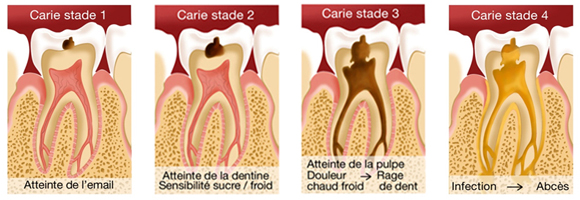Tooth caries is a major public health problem in industrialized countries. It affects 60-90% of school children and the vast majority of adult.
Evolution of the caries

Caries is an infection of the tooth which is characterized by the appearance of a cavity in the surface of the enamel. As fast as the decay progresses, the cavity will make their way to the interior of the tooth to reach the nerve. The first signs that may indicate the presence of a cavity are pain sugar, cold or warm.
Local complications of caries
When the decay is not treated at the beginning, we can see a toothache, dental abscesses or cystss.
Treatment of infection

To treat tooth decay, tooth is sleeping (unless the decay is very superficial) and the decayed portion is removed. After this first step, the tooth has a cavity that needs to be disinfected in order to reconstitute immunity from microbes, and that's toavoid the risk of recurrent caries. If the decay has reached the nerve, the tooth will necessarily be devitalized before being reconstituted.
Tooth devitalization is a fairly common act of removing the nerve of a tooth when it has been damaged by deep decay, cracks, shock...
Why devitalized infected tooth?
A deep decay or trauma (shock, broken tooth ...) can cause irreversible damage to the nerve of the tooth. When this is the case, the tooth must be devitalised because the nerve can not heal. If the tooth is not devitalized, infection eventually propagate along the root to the bone of the jaw, and cause an abscess.
How tooth is devitalized ?
Tooth devitalization under local anesthesia, consist on completely remove the nerve, disinfect inside the roots and resealed them sealingly.
Step 1 :
 An access channel is provided through the tooth to access the root.
Step 2 :
An access channel is provided through the tooth to access the root.
Step 2 :
 The length of each root is accurately determined. The roots are then cleaned and expanded using small limes then are disinfected with antiseptics.
In our dental clinic in Tunisia we use endo-mechanical equipment that allows more effective canal cleaning than hand limes .
Step 3 :
The length of each root is accurately determined. The roots are then cleaned and expanded using small limes then are disinfected with antiseptics.
In our dental clinic in Tunisia we use endo-mechanical equipment that allows more effective canal cleaning than hand limes .
Step 3 :
 Teeth roots are sealed tight to avoid reinfection.
Tooth devitalization is expected for a lifetime, but in some rare cases, it needs to be renewed. The tooth is then reopened, disinfected and then closed again.
Teeth roots are sealed tight to avoid reinfection.
Tooth devitalization is expected for a lifetime, but in some rare cases, it needs to be renewed. The tooth is then reopened, disinfected and then closed again.
Reconstruction of the tooth after Tooth devitalization
A devitalized tooth is usualy very dilapidated therefore fragile tooth. To consolidate it , it must be restored properly. Put a crown on a devitalized tooth provides complete crimp for what remains from the tooth and prevent it from splitting. In cases where the tooth is less fragile or less stressed, a simple filling can be considered.








